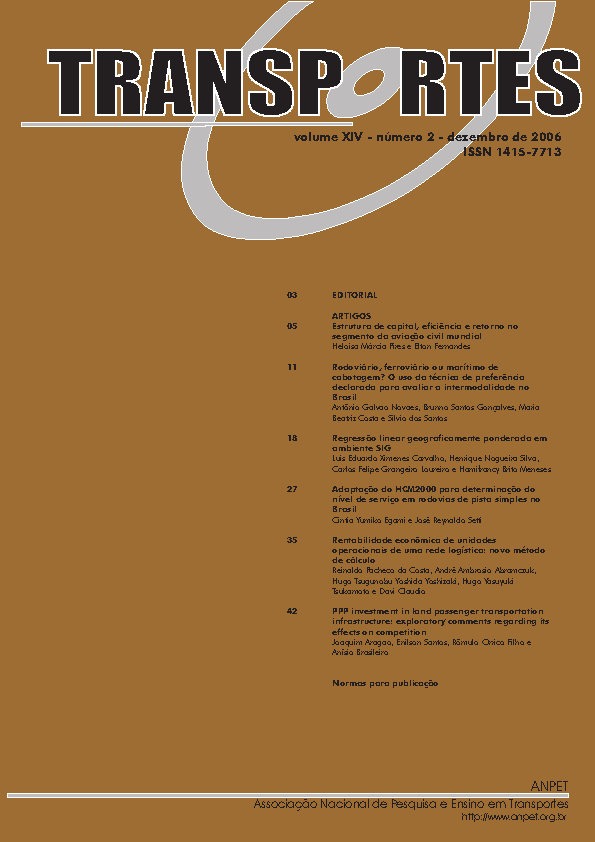Adaptação do HCM2000 para rodovias de pista simples sem faixas adicionais no Brasil
DOI:
https://doi.org/10.14295/transportes.v14i2.66Abstract
Este artigo apresenta uma adaptação do procedimento para análise do nível de serviço e capacidade proposto pelo HCM2000 para rodovias de pista simples no Brasil, realizada a partir da hipótese de que os resultados obtidos seriam melhores se o método fosse adaptado para condições típicas locais. A adaptação consistiu em obter novos valores para os seguintes fatores de ajuste usados no HCM2000: fator de pico horário (
PHF); fator de ajuste para o efeito de rampas (fG); fator de equivalência veicular (ET); fator de ajuste para zonas de ultrapassagem proibida na velocidade média de percurso (fnp) e fator de ajuste para o efeito combinado da distribuição direcional do tráfego e da porcentagem de zonas de ultrapassagem proibida na porcentagem de tempo viajando em pelotões (fd/np). Os novos valores foram obtidos a partir de simulações realizadas com uma versão do modelo TRARR calibrada para representar uma rodovia típica do Brasil. A calibração do TRARR foi realizada empregando-se um algoritmo genético. Como os valores encontrados para os fatores escolhidos, à exceção do PHF, são diferentes dos fornecidos no HCM2000, sugere-se que passem a ser usados na determinação da capacidade e nível de serviço em rodovias no Brasil no lugar daqueles empregados no HCM.
Downloads
Downloads
Published
How to Cite
Issue
Section
License
Authors who submit papers for publication by TRANSPORTES agree to the following terms:
- The authors retain the copyright and grant Transportes the right of first publication of the manuscript, without any financial charge, and waive any other remuneration for its publication by ANPET.
- Upon publication by Transportes, the manuscript is automatically licensed under the Creative Commons License CC BY 4.0 license. This license permits the work to be shared with proper attribution to the authors and its original publication in this journal.
- Authors are authorized to enter into additional separate contracts for the non-exclusive distribution of the version of the manuscript published in this journal (e.g., publishing in an institutional repository or as a book chapter), with recognition of the initial publication in this journal, provided that such a contract does not imply an endorsement of the content of the manuscript or the new medium by ANPET.
- Authors are permitted and encouraged to publish and distribute their work online (e.g., in institutional repositories or on their personal websites) after the editorial process is complete. As Transportes provides open access to all published issues, authors are encouraged to use links to the DOI of their article in these cases.
- Authors guarantee that they have obtained the necessary authorization from their employers for the transfer of rights under this agreement, if these employers hold any copyright over the manuscript. Additionally, authors assume all responsibility for any copyright infringements by these employers, releasing ANPET and Transportes from any responsibility in this regard.
- Authors assume full responsibility for the content of the manuscript, including the necessary and appropriate authorizations for the disclosure of collected data and obtained results, releasing ANPET and Transportes from any responsibility in this regard.










